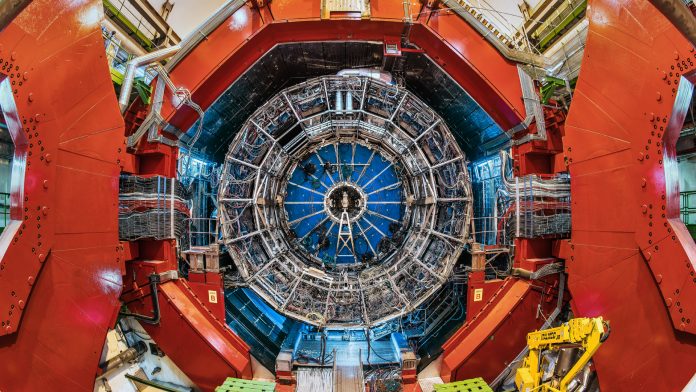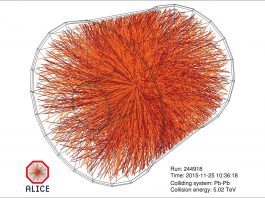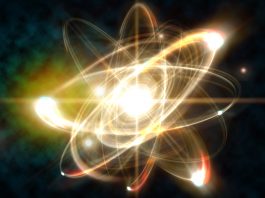Physicists Oton Vazquez Doce and Laura Fabbietti from CERN’s ALICE collaboration spoke to Innovation News Network‘s digital editor Caitlin Magee about the strong interaction hadrons.
Hadrons are made of two or three quarks tied together by a strong interaction, which is mediated by gluons. This interaction also acts between hadrons, binding nucleons (protons and neutrons) together inside atomic nuclei. CERN’s ALICE collaboration aims to understand the strong interaction between hadrons with different quark content.
The new research results achieved by the ALICE collaboration show how a technique based on measuring the momentum difference between hadrons produced in proton–proton collisions at the LHC can be used to reveal the dynamics of the strong interaction between hyperons and nucleons. The technique is called femtoscopy because it allows the investigation of spatial scales close to 1 femtometre (10−15 metres) – about the size of a hadron and the spatial range of the strong-force action.
Physicists Oton Vazquez Doce and Laura Fabbietti from the collaboration spoke to Innovation News Network‘s digital editor Caitlin Magee about the strong interaction between the composite particles.
Fabbietti explained: “These interactions can be studied only if the hadrons spend a reasonable amount of time close to each other, at a distance compatible with their sizes. Indeed, the strong interaction occurs only at these short distances.”
Examining the momentum of particles
Vazquez Doce said: “We are using the LHC to create proton-proton collisions, which results in the abundant production of the particles of interest: hyperons and nucleons. Nucleons contain only u and d quarks, the lightest of the six existing quarks, while hyperons contain at least one s (strange) quark.
“We then track the emerging particles and measure the relative momentum. In this experiment, we compared this momentum distribution with a control distribution, one in which we know there is no correlation at all between these two particles.
“In this way we obtain the correlation function, which can be mathematically related to the quantum mechanical interaction of two particles folded with the shape and size of the source that emits the particles that is created at each collision.
“This correlation is larger than unity when particles are attracted to each other and between zero and unity if the interaction is repulsive. In order to extract information from the interaction between these two particles that we have measured, we need to know the source.”
Fabbietti added: “This source is determined using experimental data measured by the ALICE collaboration. In this study, the correlation of particle-pairs where the interaction is known, for example a pair of protons, are used as a reference and the source shape and size can be determined. This research was essential to building a solid foundation for studying these interactions.”
Vazquez Doce said: “We have a tool, called CATS, that takes the source characteristics, takes the interaction predicted by different theoretical models and allows us to build the theoretical correlation function that we will compare with our data.”
CATS was created by one of Fabbietti’s students. She explained: “We have this student that failed the quantum mechanics exam twice and after he finally passed the exam with good grades, he decided that he would l do something specifically for quantum mechanics. Since this correlation function is linked to the interaction among the two particles of interest via the quantum mechanics relative wave function, this student created a Correlations Analysis Tool to solve the Schrodinger’s equation: CATS.
“This tool can use experimental data to test theories. CATS is like an interface, which allow us to take the theoretical predictions about the interaction and then transform it in a way that can be compared directly with the data.”
Lattice quantum chromodynamics calculations
Calculations known as lattice quantum chromodynamics (QCD) can be used to determine the interaction from first principles, starting from quarks and gluons interactions, but these calculations provide reliable predictions only for hadrons, such as hyperons, containing quarks heavier than those present in protons and neutrons. In the past, these interactions were studied by colliding hadrons together in scattering experiments, but these experiments are difficult to perform with unstable (i.e. rapidly decaying) hadrons such as hyperons. This difficulty has so far prevented a meaningful comparison between measurements and theory for hadron–hadron interactions involving hyperons.
Vazquez Doce said: “QCD is the theory that describes the strong interaction, and this interaction has very different regimes of study. At small energies quarks are entirely confined within hadrons and interact very strongly, while at large energies the quarks are almost free from each other and can be found is a state called Quark Gluon Plamsa (QGP). This plasma made of still interacting, but not confined quarks and gluons can be carefully studied at the LHC as well. The QCD region at small energy, when quarks are confined within hadrons, is the one where calculations are most complicated.”
Fabbietti explained: “The only possible approach available to try to calculate the interaction of hadrons starting from the quarks and gluons building blocks is realised by an extremely involved computer simulation called lattice calculations. In particular, the Japanese group HAL QCD is expert at calculating the interaction among nucleons and hyperons starting from quarks and gluons.”
Vazquez Doce said: “These lattice QCD calculations are evolving parallel to the growing computing capacity of our technology. These computers must be capable of rapidly solving equations because QCD calculations are really hungry in terms of computing resources. Now we are supposed to have reliable calculations for one framework of study that includes strange quarks.”
The importance of studying these interactions
Fabbietti added: “The ALICE measurements of the proton-Omega^- (hyperon with three strange quarks) and proton-Xi^- (hyperon with 2 strange and 1 d quarks) correlations could be compared for the first time to the results from lattice calculations. The high precision of the measurements allows us to validate the calculated proton-Xi^- interaction calculation by the HAL QCD group, while for the proton-Omega^- interaction the agreement is still not perfect.
“This result is extremely important because, these calculations can be further used because they are validated once, but also because ALICE opened an avenue for basically the measurement of the interaction of any hadrons pairs.
“In the future, we will be able to measure the proton-omega interactions even more precisely and maybe also the omega-omega interaction. Lattice calculations predict the formation of new binding molecules in both cases and the ALICE experimental data provides a unique tool to verify the existence of such states that contain several strange quarks. In the future, more complicated systems, composed of three hadrons and including charm quarks will be challenged by us.”









